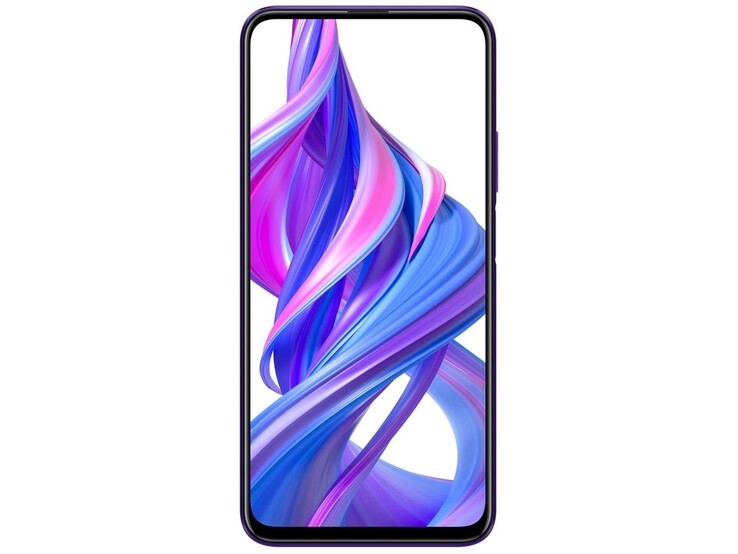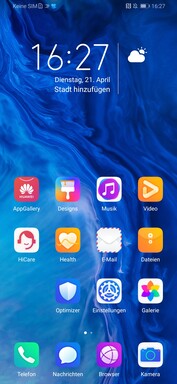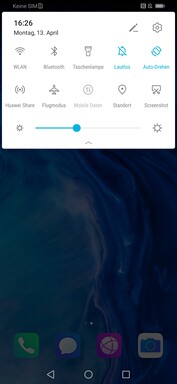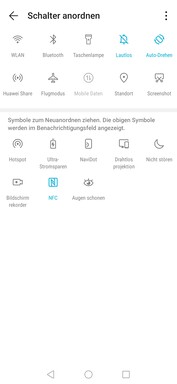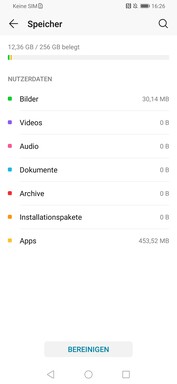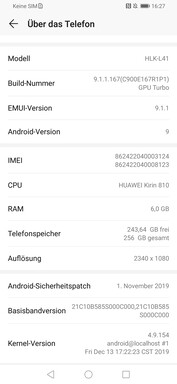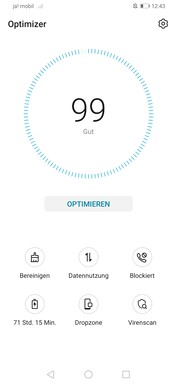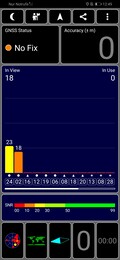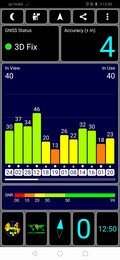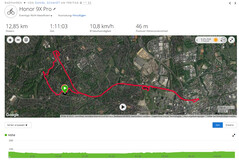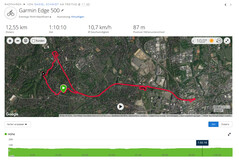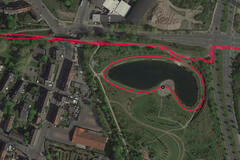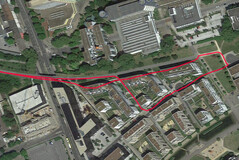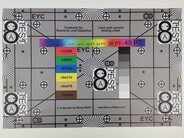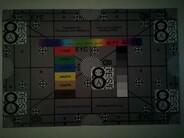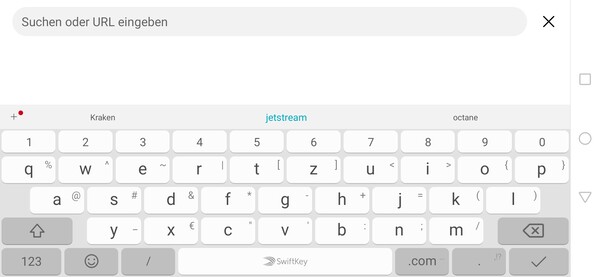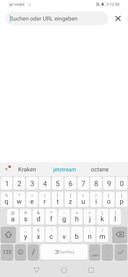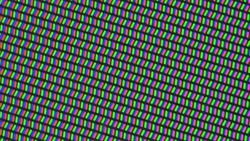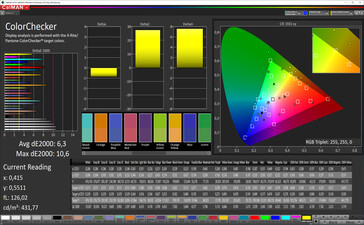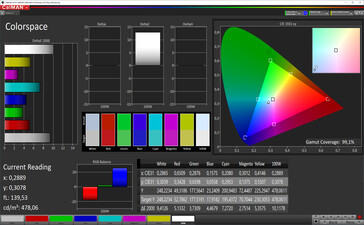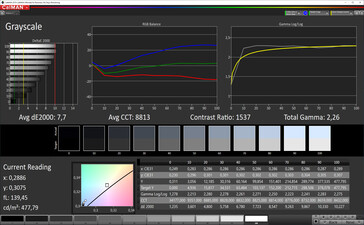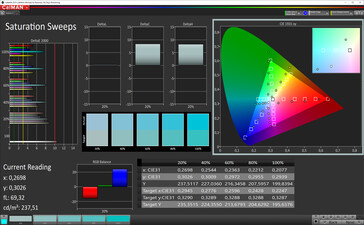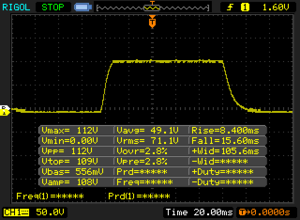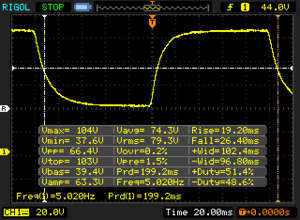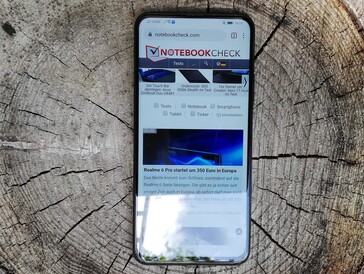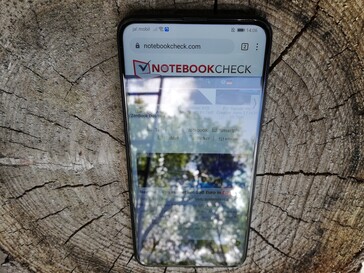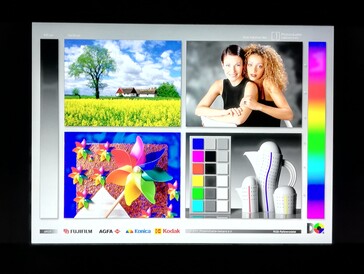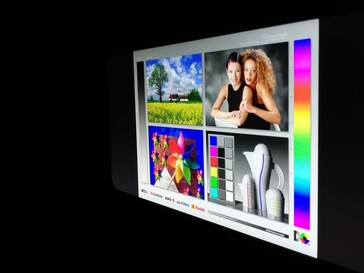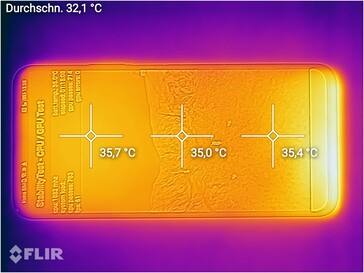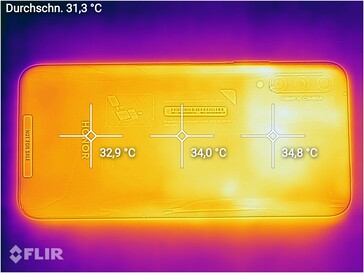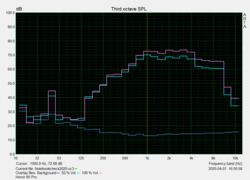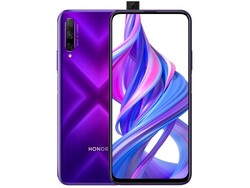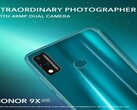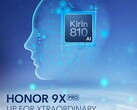Honor 9X Pro Smartphone Review: With a popup cam against the notch

While the Honor 9X could still be delivered with Google Services, the 9X Pro has to do without these services. Besides the better storage equipment, the more current SoC should be responsible to a significant extent for this, since it means that the Google license from the previous models cannot be used anymore. However, it also brings considerably more performance to the Honor 9X Pro. The Android smartphone has to compete with the comparison devices listed below.
Comparison Devices
Rating | Date | Model | Weight | Drive | Size | Resolution | Price |
|---|---|---|---|---|---|---|---|
| 79.7 % v7 (old) | 05 / 2020 | Honor 9X Pro Kirin 810, Mali-G52 MP6 | 206 g | 256 GB UFS 2.1 Flash | 6.59" | 2340x1080 | |
| 81.3 % v7 (old) | 04 / 2020 | Huawei P40 Lite Kirin 810, Mali-G52 MP6 | 183 g | 128 GB UFS 2.1 Flash | 6.40" | 2310x1080 | |
| 80.2 % v7 (old) | 01 / 2020 | TCL Plex SD 675, Adreno 612 | 192 g | 128 GB UFS 2.0 Flash | 6.53" | 2340x1080 | |
| 79.2 % v7 (old) | 11 / 2019 | Samsung Galaxy A30s Exynos 7904, Mali-G71 MP2 | 166 g | 64 GB eMMC Flash | 6.40" | 1560x720 |
Case - Robust plastic
The Honor 9X Pro is made from plastic and is available in the color "Phantom Purple." On the back, you can find the triple camera, which sticks out of the case by about 1 mm (~0.04 in). All the button controls are positioned on the edges, and the same also goes for the fingerprint sensor. On the top edge, you can clearly see the opening for the popup front camera. However, there are practically no gaps, so that dust or dirt probably cannot enter when it is closed. Right next to it, the NanoSIM/microSD card tray sits tightly in its slot.
Compared to our test field, the Honor 9X Pro is not only heavier, but also slightly larger than the competitors.
Equipment - An Android smartphone with a lot of storage
In the 9X Pro, Honor uses a HiSilicon Kirin 810, an ARM Mali-G52-MP6 graphics unit, 6 GB of RAM, and 256 GB of internal storage. The latter can be expanded by up to 512 GB via microSD card according to the manufacturer. However, you will then lose the dual-SIM function, since the Honor smartphone only has a single hybrid slot. While both slots support LTE, the VoLTE and VoWLAN functions were not available. Users also have to make do without a notification LED and DRM Widevine L1. The Camera2 API is available with the "Limited" implementation level.
Software - Android without Google Services
The user interface of the Honor 9X Pro consists of an Android-Pie system with the in-house EMUI 9.1.1 While this is oriented on a pure Android, it does come with several design adjustments and a changed structure of the Settings menu. Since the 9X Pro has to make do without Google Services, there are only the equivalent Huawei apps on the smartphone. As replacement of Google's Play Store, the App Gallery is used, which allows downloading a multitude of apps, such as WhatsApp, for example. However, automatic update functions are only available to a very limited extent.
The App Store from Amazon lends itself as an alternative, since this also offers the Facebook apps, for example. In addition, users have to find an alternative for Google Maps, if they also want to use their smartphone for navigation.
Communication and GPS - The Honor 9X Pro is suited for navigation
The Honor 9X Pro is able to connect in the GSM, 3G, and LTE networks. At close range, NFC, Bluetooth 5.0, and WiFi 5 (802.11 ac) are available. With our Netgear Nighthawk AX12 reference router, the 9X Pro reaches good data transfer rates on average in the WLAN.
| Networking | |
| iperf3 transmit AX12 | |
| Honor 9X Pro | |
| Huawei P40 Lite | |
| TCL Plex | |
| Samsung Galaxy A30s | |
| iperf3 receive AX12 | |
| TCL Plex | |
| Honor 9X Pro | |
| Huawei P40 Lite | |
| Samsung Galaxy A30s | |
The Honor smartphone can use GPS, GLONASS, Galileo, and Beidou to determine its location. Outdoors, we were able to determine our position with the "GPS Test" app with an accuracy of up to 4 meters (~13 ft). However, it was not possible to determine the location indoors.
During our mandatory bike tour, the Honor 9X Pro showed a slightly higher deviation from the route than our Garmin Edge 500 reference device particularly in the curves.
Telephone Functions and Voice Quality - A clear connection during the call
The Telephone app of the Honor 9X Pro offers direct access to a dial pad and also shows the lists of contacts and favorites. During phone calls, the Android smartphone produces a good volume and transfers voices clearly. Both conversation partners can be easily understood and additional noises are filtered out reliably.
Cameras - With an automatic popup camera
On the back of the 9X Pro, Honor has built in a triple camera with a 48-MP main sensor, an 8-MP sensor with a 120° wide-angle lens, and 2 MP for depth information. The front camera is implemented as a popup camera and allows recordings with 16 MP. Those offer vibrant colors and many details, with the edges of the objects clearly separated. However, in even areas, we can see some significant noise already at low zoom levels. Users have no direct influence on the image quality, since an AI mode automatically selects the best adjustments for the recording. While this can be deactivated, it cannot be manually adjusted. In addition, you can use beautification functions and various color filters.
The pictures taken with the main camera appear slightly pale and show less vibrant colors than the front camera. However, details are easily recognizable and objects are clearly separated. While the image content remains recognizable in bad light conditions, the structures become blurry. Although the ultra-wide-angle function of the camera is able to capture extensive panoramas, the pictures turn out slightly too dark and only have a low resolution. At 5x zoom level, even larger objects are not sharp anymore and small details become very blurry. Users also have the option to let the AI mode automatically select the best settings for the image here. However, you can also use a Pro mode to make manual adjustments for ISO, shutter speed, brightness, focus, and white balance.
The video function of the Honor 9X Pro offers a similar quality as shown in our test images. The camera handles changes between bright and dark areas in the image very well, and the image stabilizer also works well. For example, when using the 2x zoom, it ensures a very stable and even image. The maximum video resolution is 1080p, with 60 fps also being possible in the 16:9 format. Users can also choose between H.265 and H.264 coding.
The image of the ColorChecker passport shows that the Honor 9X Pro reproduces green and yellow color tones slightly too bright. On the other hand, blue and gray tones turn out slightly darker than they should be.
Under controlled test conditions, our test chart is reproduced very well. Details and structures are clearly separated, but colors appear slightly weak. In addition, there is some slight paleness in the bottom corners.
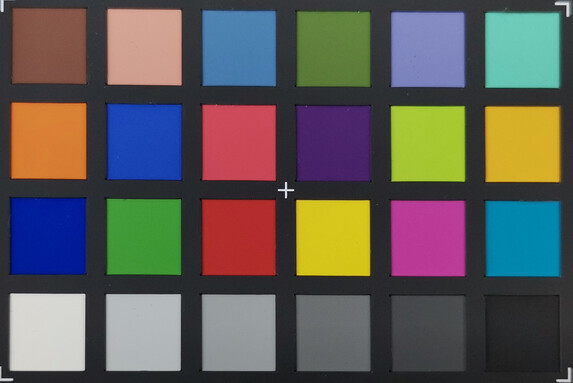
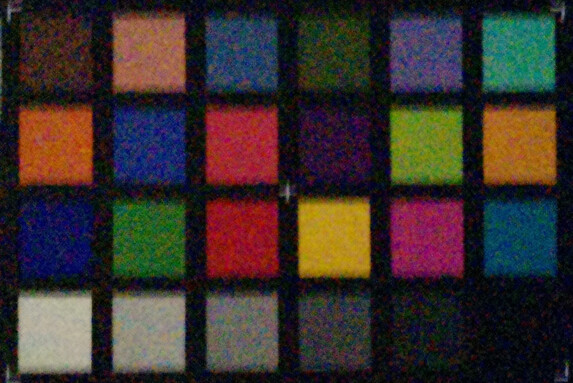
Accessories and Warranty - Honor includes the bumper case
The box of the Honor 9X Pro includes a USB charger plug with the corresponding USB Type-C cable, a SIM tool, and a silicon bumper case.
Honor offers buyers of the 9X Pro a warranty period of 24 months.
Input Devices and Operation - A fingerprint sensor on the edge
Honor uses the "SwiftKey" keyboard app for text input. This can be adjusted in a multitude of ways and offers various comfort functions. The touchscreen of the 9X Pro responds to touch very directly and reliably. But for longer drag-and-drop movements, the resistance is slightly too high.
You can unlock the smartphone comfortably using the fingerprint sensor positioned at the edge. Stored fingerprints were always recognized reliably at any time in our test.
Honor has placed the brightness sensor below the display. We did not notice any negative impact on the sensor, such as accidentally covering it with the hand.
Display - Good contrast and saturated black
Honor has equipped the 9X Pro with a 6.59 inch IPS panel with a resolution of 2340 x 1080 pixels. With the brightness sensor activated, the display achieves a maximum brightness of 488 cd/m², which can compete with the brightness of the Samsung Galaxy A30s. Without the sensor, the Honor smartphone reaches a slightly lower 474 cd/m², and in the APL50 test a similarly good 476 cd/m². The lowest brightness setting is at 1.89 cd/m².
We did not notice any PWM during our measurements.
| |||||||||||||||||||||||||
Brightness Distribution: 93 %
Center on Battery: 480 cd/m²
Contrast: 1655:1 (Black: 0.29 cd/m²)
ΔE ColorChecker Calman: 6.3 | ∀{0.5-29.43 Ø4.78}
ΔE Greyscale Calman: 7.7 | ∀{0.09-98 Ø5}
99.1% sRGB (Calman 2D)
Gamma: 2.26
CCT: 8813 K
| Honor 9X Pro IPS, 2340x1080, 6.6" | Huawei P40 Lite IPS, 2310x1080, 6.4" | TCL Plex IPS, 2340x1080, 6.5" | Samsung Galaxy A30s Super AMOLED, 1560x720, 6.4" | |
|---|---|---|---|---|
| Screen | 3% | 4% | 37% | |
| Brightness middle (cd/m²) | 480 | 478 0% | 432 -10% | 488 2% |
| Brightness (cd/m²) | 474 | 448 -5% | 418 -12% | 489 3% |
| Brightness Distribution (%) | 93 | 87 -6% | 93 0% | 93 0% |
| Black Level * (cd/m²) | 0.29 | 0.49 -69% | 0.43 -48% | |
| Contrast (:1) | 1655 | 976 -41% | 1005 -39% | |
| Colorchecker dE 2000 * | 6.3 | 3 52% | 3.4 46% | 1.7 73% |
| Colorchecker dE 2000 max. * | 10.6 | 5.6 47% | 6 43% | 3.3 69% |
| Greyscale dE 2000 * | 7.7 | 4.1 47% | 3.8 51% | 2 74% |
| Gamma | 2.26 97% | 2.26 97% | 2.14 103% | 2.1 105% |
| CCT | 8813 74% | 7282 89% | 6151 106% | 6506 100% |
* ... smaller is better
Screen Flickering / PWM (Pulse-Width Modulation)
| Screen flickering / PWM not detected | |||
In comparison: 53 % of all tested devices do not use PWM to dim the display. If PWM was detected, an average of 8121 (minimum: 5 - maximum: 343500) Hz was measured. | |||
With a contrast ratio of 1655:1 and a black value of 0.29 cd/m², image content appears vibrant and saturated on the Honor 9X Pro. However, the CalMAN analysis shows that colors are reproduced with a blue portion that is too high and a too-low red portion. In the settings menu, users can adjust the color reproduction via the "Normal" and "Vibrant" modes or by using a color temperature scale.
Display Response Times
| ↔ Response Time Black to White | ||
|---|---|---|
| 24 ms ... rise ↗ and fall ↘ combined | ↗ 8.4 ms rise | |
| ↘ 15.6 ms fall | ||
| The screen shows good response rates in our tests, but may be too slow for competitive gamers. In comparison, all tested devices range from 0.1 (minimum) to 240 (maximum) ms. » 53 % of all devices are better. This means that the measured response time is worse than the average of all tested devices (20.2 ms). | ||
| ↔ Response Time 50% Grey to 80% Grey | ||
| 45.6 ms ... rise ↗ and fall ↘ combined | ↗ 19.2 ms rise | |
| ↘ 26.4 ms fall | ||
| The screen shows slow response rates in our tests and will be unsatisfactory for gamers. In comparison, all tested devices range from 0.165 (minimum) to 636 (maximum) ms. » 77 % of all devices are better. This means that the measured response time is worse than the average of all tested devices (31.6 ms). | ||
Performance - Hardly any increase with the Performance mode
The hardware of the Honor 9X Pro corresponds to the mid-range and is suited for a multitude of tasks. Everyday apps run without any problems, and the same goes for current games. In the benchmarks, the results remain slightly below those of the Huawei P40 Lite, which has almost identical equipment.
All the benchmarks were performed using the Performance mode. Without that, the results remained about 5% lower on average.
| PCMark for Android | |
| Work performance score (sort by value) | |
| Honor 9X Pro | |
| Huawei P40 Lite | |
| Samsung Galaxy A30s | |
| Average HiSilicon Kirin 810 (9189 - 12070, n=3) | |
| Work 2.0 performance score (sort by value) | |
| Honor 9X Pro | |
| Huawei P40 Lite | |
| TCL Plex | |
| Samsung Galaxy A30s | |
| Average HiSilicon Kirin 810 (7541 - 9164, n=3) | |
| GFXBench (DX / GLBenchmark) 2.7 | |
| T-Rex Onscreen (sort by value) | |
| Honor 9X Pro | |
| Huawei P40 Lite | |
| Samsung Galaxy A30s | |
| Average HiSilicon Kirin 810 (57 - 59, n=3) | |
| Average of class Smartphone (12 - 166, n=155, last 2 years) | |
| 1920x1080 T-Rex Offscreen (sort by value) | |
| Honor 9X Pro | |
| Huawei P40 Lite | |
| Samsung Galaxy A30s | |
| Average HiSilicon Kirin 810 (85 - 89, n=3) | |
| Average of class Smartphone (22 - 954, n=155, last 2 years) | |
| GFXBench 3.0 | |
| on screen Manhattan Onscreen OGL (sort by value) | |
| Honor 9X Pro | |
| Huawei P40 Lite | |
| Samsung Galaxy A30s | |
| Average HiSilicon Kirin 810 (49 - 55, n=3) | |
| Average of class Smartphone (18 - 166, n=157, last 2 years) | |
| 1920x1080 1080p Manhattan Offscreen (sort by value) | |
| Honor 9X Pro | |
| Huawei P40 Lite | |
| Samsung Galaxy A30s | |
| Average HiSilicon Kirin 810 (47 - 53, n=3) | |
| Average of class Smartphone (12 - 606, n=156, last 2 years) | |
| GFXBench 3.1 | |
| on screen Manhattan ES 3.1 Onscreen (sort by value) | |
| Honor 9X Pro | |
| Huawei P40 Lite | |
| Samsung Galaxy A30s | |
| Average HiSilicon Kirin 810 (30 - 34, n=3) | |
| Average of class Smartphone (11 - 166, n=157, last 2 years) | |
| 1920x1080 Manhattan ES 3.1 Offscreen (sort by value) | |
| Honor 9X Pro | |
| Huawei P40 Lite | |
| Samsung Galaxy A30s | |
| Average HiSilicon Kirin 810 (33 - 35, n=3) | |
| Average of class Smartphone (8.4 - 413, n=156, last 2 years) | |
| AnTuTu v8 - Total Score (sort by value) | |
| Honor 9X Pro | |
| Huawei P40 Lite | |
| Samsung Galaxy A30s | |
| Average HiSilicon Kirin 810 (259370 - 319383, n=3) | |
| VRMark - Amber Room (sort by value) | |
| Honor 9X Pro | |
| Average HiSilicon Kirin 810 (n=1) | |
The Huawei browser is preinstalled on the Honor 9X Pro. With this, websites are loaded quickly and media content becomes available without delay. The Android smartphone also places slightly below the P40 Lite in this area.
| Jetstream 2 - 2.0 Total Score | |
| Average of class Smartphone (23.8 - 387, n=152, last 2 years) | |
| Huawei P40 Lite (Huawei Browser 10.1.0.300) | |
| Average HiSilicon Kirin 810 (43.2 - 55.4, n=3) | |
| Honor 9X Pro (Huawei Browser 10.1.0.300) | |
| Samsung Galaxy A30s (Chrome 78) | |
| JetStream 1.1 - Total Score | |
| Huawei P40 Lite (Huawei Browser 10.1.0.300) | |
| Average HiSilicon Kirin 810 (77.4 - 91.2, n=3) | |
| Honor 9X Pro (Huawei Browser 10.1.0.300) | |
| Samsung Galaxy A30s (Chrome 78) | |
| Speedometer 2.0 - Result 2.0 | |
| Average of class Smartphone (15.2 - 643, n=128, last 2 years) | |
| Huawei P40 Lite (Huawei Browser 10.1.0.300) | |
| Average HiSilicon Kirin 810 (47.3 - 53.2, n=3) | |
| Honor 9X Pro (Huawei Browser 10.1.0.300) | |
| Samsung Galaxy A30s (Chrome 78) | |
| WebXPRT 3 - Overall | |
| Average of class Smartphone (38 - 380, n=35, last 2 years) | |
| Huawei P40 Lite (Huawei Browser 10.1.0.300) | |
| Average HiSilicon Kirin 810 (71 - 97, n=3) | |
| Honor 9X Pro (Huawei Browser 10.1.0.300) | |
| Samsung Galaxy A30s (Chrome 78) | |
| Octane V2 - Total Score | |
| Average of class Smartphone (2228 - 121337, n=200, last 2 years) | |
| Huawei P40 Lite (Huawei Browser 10.1.0.300) | |
| Average HiSilicon Kirin 810 (15947 - 17925, n=3) | |
| Honor 9X Pro (Huawei Browser 10.1.0.300) | |
| Samsung Galaxy A30s (Chrome 78) | |
| Mozilla Kraken 1.1 - Total | |
| Samsung Galaxy A30s (Chrome 78) | |
| Honor 9X Pro (Huawei Browser 10.1.0.300) | |
| Average HiSilicon Kirin 810 (2472 - 3731, n=3) | |
| Huawei P40 Lite (Huawei Browser 10.1.0.300) | |
| Average of class Smartphone (257 - 28190, n=155, last 2 years) | |
* ... smaller is better
Honor uses a large 256 GB UFS-2.1 storage module in the 9X Pro. This achieves very good read and write rates in the storage benchmarks.
There is a microSD card reader to expand the storage, which also achieves very good access speeds with our Toshiba Exceria Pro M501 reference storage card.
| Honor 9X Pro | Huawei P40 Lite | TCL Plex | Samsung Galaxy A30s | Average 256 GB UFS 2.1 Flash | Average of class Smartphone | |
|---|---|---|---|---|---|---|
| AndroBench 3-5 | -11% | -30% | -50% | -14% | 163% | |
| Sequential Read 256KB (MB/s) | 769 | 913 19% | 522 -32% | 291.8 -62% | 829 ? 8% | 2225 ? 189% |
| Sequential Write 256KB (MB/s) | 434 | 181.7 -58% | 199.7 -54% | 101.7 -77% | 376 ? -13% | 1838 ? 324% |
| Random Read 4KB (MB/s) | 208.5 | 157.3 -25% | 130.8 -37% | 93.2 -55% | 168.8 ? -19% | 295 ? 41% |
| Random Write 4KB (MB/s) | 170.6 | 175.4 3% | 130.1 -24% | 13.95 -92% | 143.6 ? -16% | 334 ? 96% |
| Sequential Read 256KB SDCard (MB/s) | 82.3 ? | 82.6 ? 0% | 74.9 ? -9% | 80 ? -3% | 66.8 ? -19% | |
| Sequential Write 256KB SDCard (MB/s) | 73.3 ? | 70.6 ? -4% | 56.2 ? -23% | 64 ? -13% | 56.3 ? -23% |
Games - Smooth gaming with the Honor 9X Pro
Current games mostly run smoothly at high graphics settings on the Honor 9X Pro. The operation via touchscreen works reliably, and the position sensor can also be used easily for controlling the games. In all the games we tested with GameBench, the frame rates always remained constant.
PUBG Mobile
Asphalt 9: Legends
Emissions - The speaker lacks bass
Temperatures
In our test, the Honor 9X Pro warms up to a maximum of 32.9 °C (~91 °F). While this feels warm, it never gets hot. We did not notice any limitations that could be traced back to the temperatures being too high inside.
(+) The maximum temperature on the upper side is 32.9 °C / 91 F, compared to the average of 35.2 °C / 95 F, ranging from 21.9 to 247 °C for the class Smartphone.
(+) The bottom heats up to a maximum of 31.1 °C / 88 F, compared to the average of 34 °C / 93 F
(+) In idle usage, the average temperature for the upper side is 29.3 °C / 85 F, compared to the device average of 32.9 °C / 91 F.
Speaker
Honor 9X Pro audio analysis
(+) | speakers can play relatively loud (82.7 dB)
Bass 100 - 315 Hz
(-) | nearly no bass - on average 25.7% lower than median
(±) | linearity of bass is average (10.7% delta to prev. frequency)
Mids 400 - 2000 Hz
(±) | higher mids - on average 6.1% higher than median
(+) | mids are linear (5.1% delta to prev. frequency)
Highs 2 - 16 kHz
(+) | balanced highs - only 3.4% away from median
(+) | highs are linear (2.7% delta to prev. frequency)
Overall 100 - 16.000 Hz
(±) | linearity of overall sound is average (23.7% difference to median)
Compared to same class
» 53% of all tested devices in this class were better, 8% similar, 38% worse
» The best had a delta of 11%, average was 35%, worst was 134%
Compared to all devices tested
» 70% of all tested devices were better, 6% similar, 24% worse
» The best had a delta of 4%, average was 24%, worst was 134%
Huawei P40 Lite audio analysis
(+) | speakers can play relatively loud (88.2 dB)
Bass 100 - 315 Hz
(-) | nearly no bass - on average 28.6% lower than median
(±) | linearity of bass is average (10.7% delta to prev. frequency)
Mids 400 - 2000 Hz
(±) | reduced mids - on average 5.6% lower than median
(+) | mids are linear (5.4% delta to prev. frequency)
Highs 2 - 16 kHz
(+) | balanced highs - only 3.9% away from median
(+) | highs are linear (4.5% delta to prev. frequency)
Overall 100 - 16.000 Hz
(±) | linearity of overall sound is average (20.3% difference to median)
Compared to same class
» 33% of all tested devices in this class were better, 9% similar, 58% worse
» The best had a delta of 11%, average was 35%, worst was 134%
Compared to all devices tested
» 52% of all tested devices were better, 8% similar, 40% worse
» The best had a delta of 4%, average was 24%, worst was 134%
Battery Life - The large battery lasts for a long time
Power Consumption
The power consumption of the Honor 9X Pro is at the same level as that of other devices with this SoC. Overall, the Android smartphone can be called "efficient."
The included charger has a power output of 10 watts.
| Off / Standby | |
| Idle | |
| Load |
|
Key:
min: | |
| Honor 9X Pro 4000 mAh | Huawei P40 Lite 4200 mAh | TCL Plex 3820 mAh | Samsung Galaxy A30s 4000 mAh | Average HiSilicon Kirin 810 | Average of class Smartphone | |
|---|---|---|---|---|---|---|
| Power Consumption | 1% | -3% | 17% | -26% | -29% | |
| Idle Minimum * (Watt) | 0.7 | 0.79 -13% | 0.73 -4% | 0.79 -13% | 0.927 ? -32% | 0.848 ? -21% |
| Idle Average * (Watt) | 2.29 | 2.14 7% | 2.17 5% | 1.98 14% | 3 ? -31% | 1.435 ? 37% |
| Idle Maximum * (Watt) | 2.32 | 2.23 4% | 2.23 4% | 2.03 12% | 3.06 ? -32% | 1.621 ? 30% |
| Load Average * (Watt) | 3.57 | 3.6 -1% | 4.56 -28% | 2.37 34% | 4.39 ? -23% | 6.99 ? -96% |
| Load Maximum * (Watt) | 5.76 | 5.17 10% | 5.22 9% | 3.68 36% | 6.33 ? -10% | 11.3 ? -96% |
* ... smaller is better
Battery Life
In our realistic WLAN test, the Honor 9X Pro achieves a very good runtime of more than 16 hours. With this, it is able to make better use of its 4000-mAh battery than, for example, the Samsung Galaxy A30s.
Even though there is no label about any quick-charge technology on the included charger, our test unit is already fully recharged after about 2 hours.
| Honor 9X Pro 4000 mAh | Huawei P40 Lite 4200 mAh | TCL Plex 3820 mAh | Samsung Galaxy A30s 4000 mAh | |
|---|---|---|---|---|
| Battery runtime | ||||
| WiFi v1.3 (h) | 16.2 | 16.8 4% | 10.3 -36% | 10.6 -35% |
Pros
Cons
Verdict - A very good price-performance ratio
In our test, the Honor 9X Pro reveals itself as a smartphone with a good price-performance ratio. The hardware offers more than enough performance for most applications, and the generous amount of internal storage prevents fears of running out of storage. In combination with 6 GB of RAM and a very good battery life, there are hardly any desires that remain unfulfilled. On the other hand, the Honor 9X Pro was unable to completely convince us with its particular feature, the popup selfie camera. Although the colors look relatively good, and the reproduced objects are also quite presentable, we like the image noise on even surfaces less.
The Honor 9X Pro continues the known direction of the manufacturer consistently, but has to make do without Google Services.
The main camera also leaves room for improvement, when objects appear too dark and slightly pale. The lack of Google Services is primarily a question of comfort. Those who are willing to install their apps via Huawei's App Gallery or Amazon's App Store should be able to also get along well with the available alternatives. However, without Google, you cannot simply take a picture of a QR code and load the app in the Play Store anymore. But the Honor 9X Pro still has a lot to offer for 250 Euros (~$271).
Honor 9X Pro
- 05/07/2020 v7 (old)
Mike Wobker




